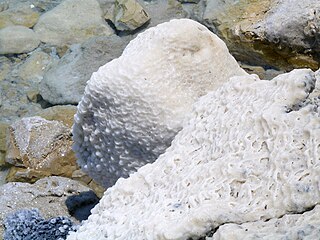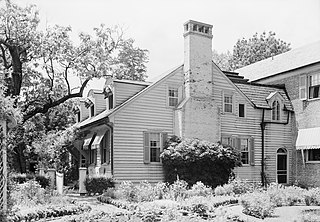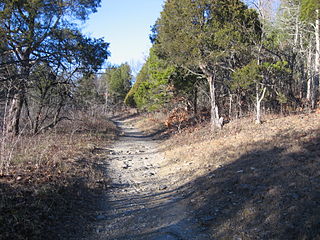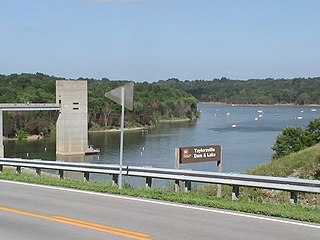Mann's Lick was a salt lick just north of the present-day Fairdale neighborhood of Louisville, Kentucky. It was named for John Mann, who belonged to a surveying party of Captain Thomas Bullitt in 1773. [1]
Fairdale is a former census-designated place in southern Jefferson County, Kentucky, United States. The population was 7,658 at the 2000 census. In 2003, the area was annexed to the city of Louisville due to a merger between the city and Jefferson County's unincorporated community. Fairdale is now a neighborhood within the city limits of Louisville. It is within the boundaries of the Fairdale Fire Protection District which serves Fairdale and surrounding areas including the large Jefferson Memorial Forest and historic South Park Country Club, the oldest country club in the state of Kentucky.

Louisville is the largest city in the Commonwealth of Kentucky and the 29th most-populous city in the United States. It is one of two cities in Kentucky designated as first-class, the other being Lexington, the state's second-largest city. Louisville is the historical seat and, since 2003, the nominal seat of Jefferson County, located in the northern region of the state, on the border with Indiana.
Thomas Bullitt was a United States soldier and pioneer from Prince William County, Virginia.
The land was given to Colonel John Todd in 1780. When Todd died at the Battle of Blue Licks in 1782, the land went to his daughter Mary O. Todd. Joseph Brooks leased the land from Mary Todd in 1787, starting the saltworks immediately. [2]

The Battle of Blue Licks, fought on August 19, 1782, was one of the last battles of the American Revolutionary War. The battle occurred ten months after Lord Cornwallis's surrender at Yorktown, which had effectively ended the war in the east. On a hill next to the Licking River in what is now Robertson County, Kentucky, a force of about 50 American and Canadian Loyalists along with 300 American Indians ambushed and routed 182 Kentucky militiamen. It was the last victory for the Loyalists and Indians during the frontier war.
Brooks had originally been from Pennsylvania. He and his wife Nancy had left their home in 1779, traveling down the Ohio River to Maysville, Kentucky, and then walking the rest of the way to the Louisville area. He started working at Thomas Bullitt's Bullitt's Lick salt works, near Shepherdsville, Kentucky in 1784. After acquiring the Mann's Lick salt lick, he decided to build a salt furnace. He started by constructing a hollow-log pipe to pump water to his salt furnace; remains of these hollow logs were still available to be seen in the 1940s. [3] Due to fear of Indian attack, fortifications were built to protect the site in 1788. [4]

Pennsylvania, officially the Commonwealth of Pennsylvania, is a state located in the northeastern and Mid-Atlantic regions of the United States. The Appalachian Mountains run through its middle. The Commonwealth is bordered by Delaware to the southeast, Maryland to the south, West Virginia to the southwest, Ohio to the west, Lake Erie and the Canadian province of Ontario to the northwest, New York to the north, and New Jersey to the east.

The Ohio River is a 981-mile (1,579 km) long river in the midwestern United States that flows southwesterly from western Pennsylvania south of Lake Erie to its mouth on the Mississippi River at the southern tip of Illinois. It is the second largest river by discharge volume in the United States and the largest tributary by volume of the north-south flowing Mississippi River that divides the eastern from western United States. The river flows through or along the border of six states, and its drainage basin includes parts of 15 states. Through its largest tributary, the Tennessee River, the basin includes several states of the southeastern U.S. It is the source of drinking water for three million people.

Maysville is a home rule-class city in Mason County, Kentucky, United States and is the seat of Mason County. The population was 9,011 at the 2010 census, making it the 40th-largest city in Kentucky by population. Maysville is on the Ohio River, 66 miles (106 km) northeast of Lexington. It is the principal city of the Maysville Micropolitan Statistical Area, which includes Mason and Lewis counties. Two bridges cross the Ohio from Maysville to Aberdeen, Ohio: the Simon Kenton Memorial Bridge built in 1931 and the William H. Harsha Bridge built in 2001.
Due to salt being a necessary item in human life, hundreds of workers were used to obtain the salt, including numerous slaves. Some of these workers began settling on 150 acres (0.61 km2) of James F. Moore's land, causing the charter in 1794 for the new town of Newtown. It was sold under numerous brands, most prominently Little Sandy Salt. The salt was considered excellent quality, prized by merchants, and was sold as far away as Lexington, Kentucky. In 1808 it was sold for $2–2.25 a bushel, although it was often traded for such goods as hemp, linen, and tobacco. [5] At its height the salt works was operated 24 hours a day. [4]

Salt is a mineral composed primarily of sodium chloride (NaCl), a chemical compound belonging to the larger class of salts; salt in its natural form as a crystalline mineral is known as rock salt or halite. Salt is present in vast quantities in seawater, where it is the main mineral constituent. The open ocean has about 35 grams (1.2 oz) of solids per liter of sea water, a salinity of 3.5%.

Lexington, consolidated with Fayette County and often denoted as Lexington-Fayette, is the second-largest city in Kentucky and the 60th-largest city in the United States. By land area, Lexington is the 28th largest city in the United States. Known as the "Horse Capital of the World," it is the heart of the state's Bluegrass region. It has a nonpartisan mayor-council form of government, with 12 council districts and three members elected at large, with the highest vote-getter designated vice mayor. In the 2018 U.S. Census Estimate, the city's population was 323,780 anchoring a metropolitan area of 516,697 people and a combined statistical area of 746,330 people.

A bushel is an imperial and US customary unit of weight or mass based upon an earlier measure of dry capacity. The old bushel was equal to 2 kennings (obsolete), 4 pecks or 8 dry gallons and was used mostly for agricultural products such as wheat. In modern usage, the volume is nominal, with bushels denoting a mass defined differently for each commodity.
Eventually, the salt lick went out of business, as it was not as big as other nearby salt licks, such as Bullitt's Lick, and steamboats brought cheaper salt to Louisville. By 1830 the population and salt had dwindled, and by 1890 a change in Kentucky's constitution caused Newtown to officially dissolve. [6]

Kentucky, officially the Commonwealth of Kentucky, is a state located in the east south-central region of the United States. Although styled as the "State of Kentucky" in the law creating it, (because in Kentucky's first constitution, the name state was used) Kentucky is one of four U.S. states constituted as a commonwealth. Originally a part of Virginia, in 1792 Kentucky became the 15th state to join the Union. Kentucky is the 37th most extensive and the 26th most populous of the 50 United States.
The area had attained a negative reputation by Louisvillians between 1830 and 1910. From 1830 to 1860 there were various battles over who owned the land. In 1844 it was given to Margaret W. Preston, as she was the favorite stepdaughter of her father's (William Preston) wife, Polly Wickliffe. In 1870 an attempt to find oil on the land was made by the Manslick Petroleum Company. Margaret W. Preston would continue to own the land through the 1880s as she saw it as "the gift of the best friend I ever had on earth", referring to her stepmother. In 1886 it had become part of the land for a natural gas company. By 1910 new residents came to the area. As they were unaware of the site's history, they gave it a new name, Fairdale, instead of its old name of Newtown. [7]

William Preston was an American lawyer, politician, and ambassador. He also was a brigadier general in the Confederate Army during the American Civil War.

Natural gas, also called "Fossil Gas" is a naturally occurring hydrocarbon gas mixture consisting primarily of methane, but commonly including varying amounts of other higher alkanes, and sometimes a small percentage of carbon dioxide, nitrogen, hydrogen sulfide, or helium. It is formed when layers of decomposing plant and animal matter are exposed to intense heat and pressure under the surface of the Earth over millions of years. The energy that the plants originally obtained from the sun is stored in the form of chemical bonds in the gas.
The name lives on, as Manslick Road attained its name from the former salt lick. [6]












